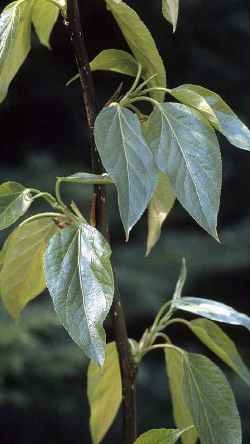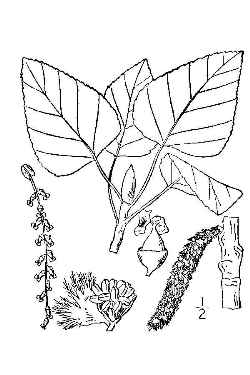Balsam Poplar, Balm of Gilead
Scientific Name: Populus balsamifera L.
Synonym: Populus candicans, Populus michauxii, Populus tacamahaca
Family: Salicaceae

Populus balsamifera, Lynden Gerdes. USDA NRCS. 1995. Northeast wetland flora: Field office guide to plant species. Northeast National Technical Center, Chester, PA. Courtesy of USDA NRCS Wetland Science Institute.
Sunset®: All zones
USDA: 3-10
Heat Tolerance: A good species for the lower deserts, if water use is not a concern
Sun Exposure: Full sun
Origin: Northern and central North America
Growth Habits: Deciduous tree, 40 to 60 feet tall (12-18 m) or more, 20 to 30 feet spread (6-9 m); bark on young tree is green, becoming grey, furrowed, as the tree ages; triangular leaves, 4.4 to 6 inches long (11-15 cm), 3 to 4 inches wide (7.5-10 cm)
Watering Needs: Regular deep watering
Propagation: Cuttings, abundant suckers

Britton, N.L., and A. Brown. 1913. Illustrated flora of the northern states and Canada. Vol. 1: 588.
The species epithet "balsamifera" comes from the Latin for "balsam bearing", because of its sticky, resinous, and strongly aromatic buds. The resin of the buds has been used medicinally.
Populus × brayshawii is a hybrid of Populus angustifolia × Populus balsamifera
Blooming Habits:
Dioecious. The male trees bear smaller catkins, than the female trees.
Desert-Tropicals is dedicated to provide gardening advice, gardening ideas, and information about flower of all kind for landscape and collections.We try to check carefully the identification of the plants on the illustrations as well as the other information from the page, but occasionally errors do occur. if you notice anything that needs to be changed please contact us.Thanks.
© 1998-2020 Philippe Faucon, All Rights Reserved.